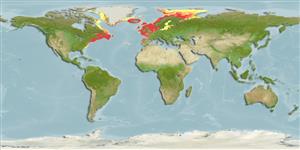>
Clupeiformes (Herrings) >
Clupeidae (Herrings, shads, sardines, menhadens)
Etymology: Clupea: Latin, clupea = sardine, derived from Clupeus = shield; doubtless a reference to the scales covering the body of the fish + Greek, odous = teeth (Ref. 45335).
More on author: Linnaeus.
Environment: milieu / climate zone / depth range / distribution range
экология
морской; солоноватоводный донно-пелагический; мигрирует в океане (Ref. 51243); пределы глубины 0 - 364 m (Ref. 58426), usually 0 - 200 m (Ref. 6683). Temperate; 1°C - 18°C (Ref. 188); 80°N - 33°N, 95°W - 70°E
North Atlantic: in the west, it ranges from southwestern Greenland and Labrador southward to South Carolina, USA. In the east, it ranges from Iceland and southern Greenland southward to the northern Bay of Biscay and eastward to Spitsbergen and Novaya Zemlya in Russia, including the Baltic Sea (Ref. 188).
Length at first maturity / Size / Вес / Возраст
Maturity: Lm 16.7 range ? - ? cm
Max length : 45.0 cm SL самец/пол неопределен; (Ref. 37032); common length : 30.0 cm SL самец/пол неопределен; (Ref. 37032); наибольший вес (опубликованные данные): 1.1 kg (Ref. 6114); наибольший возраст (опубликованны данные): 25 годы (Ref. 89560)
колючие лучи спинного плавника (общее число): 0; членистые (мягкие) лучи спинного плавника (общее число): 13-21; колючие лучи анального плавника 0; членистые (мягкие) лучи анального плавника: 12 - 23; позвонки: 51 - 60. Slender fish with a round belly. Scutes without prominent keel; 12 to 16 post-pelvic scutes (Ref. 188). No median notch in upper jaw; operculum without radiating bony striae; the posterior border of its gill opening is evenly rounded. It is blue to greenish-blue dorsally, becoming silvery ventrally. No distinctive dark spots on the body or fins (Ref. 188).
Herring schools move between spawning and wintering grounds in coastal areas and feeding grounds in open water by following migration patterns learned from earlier year classes (Ref. 88171). Juveniles (up to 2 years) shoal close inshore, while adults are found more offshore (Ref. 6683). Adults spend the day in deeper water, but rise to shallower water at night (Ref. 89562). Light is an important factor in controlling their vertical distribution. A facultative zooplanktivorous filter-feeder, i.e., it can switch to filter-feeding if the food density and particle size are appropriate (Ref. 28664). Feed mainly on copepods finding food by visual sense. Herring schools often attract predators such as fish, birds, and marine mammals (Ref. 89563). Schooling, silvery sides, excellent hearing (capable of detecting frequencies between 30-4,000 Hz , Refs. 89391, 89564, 89566), and very fast escape response act as anti-predator devices (Ref. 28664). The most important races in the East Atlantic are the winter-spawning Norwegian and Icelandic herring, the autumn spawning Icelandic and North Sea herring and the Baltic Sea herring. Utilized fresh, dried or salted, smoked, canned and frozen; can be fried, broiled, microwaved and baked (Ref. 9988).
The herring matures between 2-9 years (Refs. 35388, 82767, 89571). Herring populations are known to use traditional spawning grounds, many of which are along shallow coastal areas (15-40 m depth) or on offshore banks down to 200 m (Refs. 6684, 89572). Spawning usually occurs on gravel or rock bottoms, with the exception of Baltic populations which show a preference for shallow (less than 10 m depth) seaweed beds (Refs. 89520, 89572). Each population spawns only once a year over a relatively short time period (Ref. 89573). At least one population is spawning in any one month of the year, each having a different spawning time and place. The herring is a demersal spawner that releases a ribbon of sticky eggs that sink to the sea bed (Ref. 89574) and adhere to the substrate. The eggs released by a spawning population may be several layers thick which may deprive eggs in the bottom layers of oxygen, causing egg mortality (Ref. 89563). Although higher fecundities were reported earlier (e.g. Ref. 74523), fecundity now ranges from 10,000-60,000 eggs (Ref. 89571). Hatching may take up to 3 weeks, depending on temperature (Ref. 89571). Larvae are pelagic and drift with the current. Note: it is impossible to summarize briefly the wide range of spawning strategies of Atlantic herring; the best reviews are those of Svetovidov (Refs. 4608, 4609) for the Eastern Atlantic Ocean and Hildebrand (Ref. 4607) for the Western Atlantic Ocean.
Whitehead, P.J.P., 1985. FAO Species Catalogue. Vol. 7. Clupeoid fishes of the world (suborder Clupeoidei). An annotated and illustrated catalogue of the herrings, sardines, pilchards, sprats, shads, anchovies and wolf-herrings. FAO Fish. Synop. 125(7/1):1-303. Rome: FAO. (Ref. 188)
Статус Красного Списка МСОП (Ref. 130435)
Угроза для людей
Harmless
Использование человеком
рыболовство: важный объект промысла; объект спортивного рыболовства: да
дополнительная информация
инструменты
Специальные отчеты
Скачать в формате XML
ресурсы в Интернет
Estimates based on models
Preferred temperature (Ref.
123201): 0.5 - 11.2, mean 6.6 °C (based on 912 cells).
Phylogenetic diversity index (Ref.
82804): PD
50 = 0.6250 [Uniqueness, from 0.5 = low to 2.0 = high].
Bayesian length-weight: a=0.00562 (0.00495 - 0.00638), b=3.09 (3.05 - 3.13), in cm total length, based on LWR estimates for this species (Ref.
93245).
Trophic level (Ref.
69278): 3.4 ±0.1 se; based on diet studies.
Generation time: 3.3 (3.1 - 3.5) years. Estimated as median ln(3)/K based on 85
growth studies.
устойчивость к внешним воздействиям (Ref.
120179): средний (среднего размера), минимальное время удвоения популяции 1.4-4.4 года (rm=0.1-0.5; K=0.2-0.6; tm=2-5; tmax=25; Fec=17,300-301,000).
Prior r = 0.45, 95% CL = 0.30 - 0.68, Based on 40 stock assessments.
Fishing Vulnerability (Ref.
59153): Moderate vulnerability (41 of 100).
Climate Vulnerability (Ref.
125649): Low to moderate vulnerability (29 of 100).
Nutrients (Ref.
124155): Calcium = 75.4 [22.6, 182.8] mg/100g; Iron = 0.372 [0.199, 0.704] mg/100g; Protein = 17.5 [15.5, 19.5] %; Omega3 = 0.915 [0.561, 1.451] g/100g; Selenium = 16.5 [5.4, 49.4] μg/100g; VitaminA = 29.1 [6.6, 129.0] μg/100g; Zinc = 1.03 [0.58, 1.64] mg/100g (wet weight); based on
nutrient studies.
